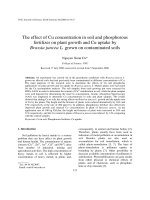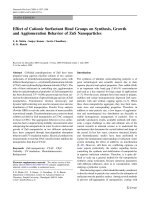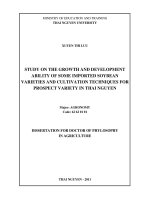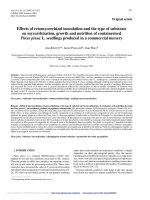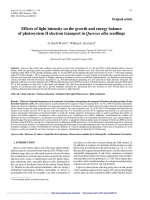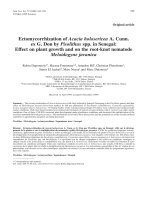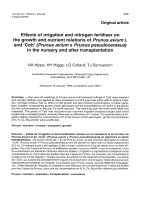Phytohormones on cell growth and taxol accumulation via cell culture of taxus wallichiana zucc
Bạn đang xem bản rút gọn của tài liệu. Xem và tải ngay bản đầy đủ của tài liệu tại đây (22.59 MB, 122 trang )
VIET NAM NATIONAL UNIVERSITY – HOCHIMINH CITY
INTERNATIONAL UNIVERSITY
STUDIES OF THE EFFECTS OF NUTRIENT MEDIA AND
PHYTOHORMONES ON CELL GROWTH AND TAXOL
ACCUMULATION VIA CELL CULTURE OF
TAXUS WALLICHIANA ZUCC.
A thesis submitted to
The School Biotechnology, International University
In partial fulfillment of the requirements for the degree of
M.Sc. in Biotechnology
Student name: PHẠM CAO KHẢI – MBT02003
Supervisor: A/Prof. Tran Van Minh
January, 2013
ACKNOWLEDGEMENTS
I wish to express my sincere gratitude to all those who gave me the possibility to
complete this thesis.
My profound appreciation goes to my advisor Associate Professor Tran Van Minh
for his tremendous suggestions, encouragement and expertise. I sincerely thank for his
confidence and faith on me throughout my research project.
I would like to thank Institute of Tropical Biology for giving me the permission to
commence my research project in the first instance, to do the necessary research work and
to use the laboratory equipments. I am bound to all officers from the institute for their
stimulating support.
I would like to send special thanks to my colleagues from Key Laboratory of Plant
Cell Biotechnology for their consistent support. I am immensely grateful to Mr. Nguyen
Trung Hau and Mr. Nguyen Phi Vien Phuong for sharing their knowledge in tissue culture,
technical advice and precious comments throughout this period. I would like to give my
special thank to Miss. Mai Thi Phuong Hoa and Mr. Do Tien Vinh for supporting me to
identify taxol content of cultures using HPLC in this study. I am also thankful to Dr. Thanh
Do for looking closely at my thesis writing and offering outstanding suggestions for
improvement. I would like to acknowledge the International University through Science
and Technology Development Program funding that supported my study.
Finally, I wish to thank my family for their love and encouragement which enabled
me to achieve this goal.
i
TABLE OF CONTENTS
ACKNOWLEDGEMENTS ...................................................................................... i
TABLE OF CONTENTS .......................................................................................... ii
ABBREVIATION ..................................................................................................... v
LIST OF FIGURES .................................................................................................. vi
LIST OF TABLES .................................................................................................... vii
ABSTRACT .............................................................................................................. viii
CHAPTER 1: INTRODUCTION............................................................................. 1
1.1 Problem Statement.................................................................................. 2
1.2 Background Study .................................................................................. 3
1.3 Objectives............................................................................................... 5
1.4 Contents of the study .............................................................................. 5
1.5 Long-term Goals..................................................................................... 6
CHAPTER 2: LITERATURE REVIEW ................................................................. 7
2.1 Background information of the Taxus sp. Genus..................................... 8
2.1.1. Scientific classification.................................................................. 8
2.1.2. Taxus sp. in Vietnam ..................................................................... 9
2.2 Biosynthesis of Secondary metabolites in plant ...................................... 13
2.3 Background of Paclitaxel........................................................................ 15
2.3.1 Chemical Structure......................................................................... 15
2.3.2 Discovery History and Application................................................. 15
2.3.3 Activity Mechanism of Taxol......................................................... 18
2.3.4 Taxol Production ............................................................................ 18
2.4 Taxol Biosynthesis ................................................................................. 21
2.4.1. First step: Geranylgeranyl pyrophosphate (GGPP) biosynthesis .... 21
2.4.2. Second step: The incorporation of GGPP in taxol biosynthesis...... 22
2.5 Plant cell culture for producing secondary metabolites ........................... 23
2.5.1 Optimization of cultural conditions ................................................ 25
2.5.2 Selection of high-producing strains ................................................ 25
2.5.3 Precursor feeding ........................................................................... 26
ii
2.5.4 Elicitation....................................................................................... 27
2.6 Taxus cell culture for producing taxol..................................................... 27
2.6.1 Background information of Taxus cell culture................................ 27
2.6.2 Two stage culture ........................................................................... 31
2.6.3 Effect of some physical and chemical factors on cell growth and taxol
accumulation of Taxus cell suspension .............................................................. 32
2.7 Application of bioreactor techniques for producing of secondary
metabolites ........................................................................................................ 37
CHAPTER 3: MATERIALS AND METHODS ...................................................... 38
3.1 Materials ................................................................................................ 39
3.1.1 Plant Material................................................................................. 39
3.1.2 Media Components and Preparation ............................................... 39
3.1.3 Laboratory Facilities ...................................................................... 42
3.2 Methods.................................................................................................. 43
3.2.1 Experimental scheme ..................................................................... 43
3.2.2 Callus culture ................................................................................. 44
3.2.3 Cell suspension cultures ................................................................. 46
3.2.4 Cell Growth Measurement.............................................................. 50
3.2.5 Data Collection .............................................................................. 51
3.2.6 Statistical Analysis ......................................................................... 53
CHAPTER 4: RESULTS AND DISCUSSION ........................................................ 54
4.1 Callus Culture......................................................................................... 55
4.1.1 Effect of mineral media and phytohormones on callus induction and
growth ............................................................................................................... 55
4.1.2 Proliferation of callus biomass ....................................................... 61
4.1.3 Determination of kinetic of callus growth....................................... 66
4.2 Cell suspension culture ........................................................................... 67
4.2.1 Establishment of cell suspension culture......................................... 67
4.2.2 Effect of phytohormones on cell suspension proliferation............... 69
4.2.3 Effect of organic compounds on cell suspension proliferation ........ 71
4.3 Elicitation ............................................................................................... 75
iii
4.3.1. Effect of the phenylalanine and elicitors on taxol accumulation..... 75
4.3.2. Effect of adding time of elicitor on taxol accumulation ................. 81
4.3.3. Effect of exposure time with elicitor on taxol accumulation .......... 82
CHAPTER 5: SUMMARY AND CONCLUSION................................................... 84
REFERENCE............................................................................................................ 87
APPENDICES........................................................................................................... 99
iv
ABBREVIATIONS
2,4-D
2,4-Dichloropheonoxyacetic acid
2iP
2-isopentyladenine
BA
6-Benzylaminopurine
IAA
Indole-3-acetic acid
MS
Murashige and Skoog
NAA
Naphthalene acetic acid
WPM
Loyd & McCown (1980) medium
B5
Gamborg (1968) medium
2,4-D
2,4-dichlorophenoxy acetic acid
ISO
International Organization for Standardization
Cs
Colleagues
Cw
Coconut water
YE
Yeast Extract
O-CHI
Oligo Chitosan
CH
Casein hydrolysate
MJ
Methyl jamonate
SA
Salycilic acid
PE
Peptone
ME
Malt Extract
DW
Dry cell weight
Ki
Kinetin (6-Benzyl-aminopurine)
LV
Litvay (1985)
PVP
Polyvinylpyrrolidone
v
LIST OF FIGURES
Figure 2.1. Taxus wallichiana Zucc. grown using cutting technique ............. 9
Figure 2.2. Main pathway for leading to secondary metabolite in plant....... 14
Figure 2.3. Important compounds in Taxus sp. .............................................. 15
Figure 2.4. Schematic representation of taxol mechanism of action ............. 18
Figure 2.5. Total taxol biosynthetic pathway in Taxus species ...................... 22
Figure 3.1. Taxus wallichiana Zucc................................................................. 39
Figure 4.1. Callus induction on different mineral media ............................... 56
Figure 4.2. Callus induction and growth on B5 media with different auxins59
Figure 4.3. Callus proliferation on B5 media with different auxins .............. 62
Figure 4.4. Difference in callus proliferation between treatments of sucrose
supplementation............................................................................................... 64
Figure 4.5. Callus proliferation on B5 media with various organics ............. 65
Figure 4.6. Kinetics of callus growth of Taxus wallichiana Zucc................... 66
Figure 4.7. Initiation of cell suspension cultures ............................................ 68
Figure 4.8. Morphology of single cells and cell clusters ................................. 70
Figure 4.9. Cell suspension proliferation on medium B5 with different
organics ............................................................................................................ 73
Figure 4.10. Kinetics of cell growth of Taxus wallichiana Zucc in liquid
medium............................................................................................................. 74
Figure 4.11. Difference in cell growth between treatments of elicitor
supplementation............................................................................................... 80
vi
LIST OF TABLES
Table 3.1. Media formation of callus proliferation ........................................ 45
Table 3.2. Media Formation of cell suspension proliferation ........................ 47
Table 4.1. Influence of 2,4-D and mineral media on callus induction ........... 57
Table 4.2. Influence of NAA and mineral media on callus induction............ 58
Table 4.3. Influence of 2,4-D and NAA on callus proliferation ..................... 61
Table 4.4. Influence of sucrose on callus proliferation................................... 63
Table 4.5. Influence of Coconut water and Glycine on callus proliferation.. 65
Table 4.6. Influence of 2,4-D and NAA on cell proliferation ......................... 69
Table 4.7. Influence of organic compounds on cell proliferation .................. 72
Table 4.8. Influence of the phenylalanine and elicitors on cell growth and taxol
accumulation.................................................................................................... 76
Table 4.9. Effect of adding time of elicitor on taxol accumulation ................ 81
Table 4.10. Effect of exposure time with elicitor on taxol accumulation ....... 82
vii
ABSTRACT
Taxus wallichiana Zucc., an important medicinal plant, is the main source of
paclitaxel, a diterpene alkaloid of commercial interest for pharmacological properties.
Toward the main objective of in vitro production of paclitaxel, the specific objectives of
this research were i) to investigate medium components for optimizing cell growth and
paclitaxel accumulation via callus and cell suspension cultures ii) to enhance paclitaxel
production using precursors and abiotic elicitors.
For optimization of cell growth, high frequency of callus formation (100%) was
obtained from young stem explants on WP solid medium, but B5 medium was the best one
for callus growth supplemented with 2,4-D (4.0 mg/l). The friable and reddish, light brown
callus masses collected for cell culture proliferated with high growth index (3.07) on
medium B5 supplemented with 2,4-D (4.0 mg/l), NAA (2.0 mg/l), sucrose (30 g/l), glycine
(10 mg/l) and Cw (10%). The growth rate of callus was highest between 14th and 28th day
of culture period, and the appropriate subculture time was day 35 favored optimal growth
of callus. Subsequently, cell suspension cultures were established by transferring selected
friable calluses to liquid medium for their further growth and enhancement of paclitaxel
biosynthesis. Cell growth of Taxus wallichiana Zucc in liquid medium supplemented with
2,4-D (3 mg/l), NAA (3 mg/l), sucrose (30 g/l), Cw (10 %), Glycine (10 mg/l), Casein
hydrolysate (1000 mg/l) increased significantly with high growth coeffection.
For elicitation of paclitaxel biosynthesis, the suitable concentration of phenylalanine
for paclitaxel production (0.518 mg/g DW) was 15 mg/l which was 1.254 times higher than
the control. The addition of O-chi in cell cultures strongly promoted the biosynthesis of
paclitaxel whereas Yeast extract, Salycilic acid showed little effect. O-chi was the most
appropriate substrate for paclitaxel production and its optimal concentration was 5 mg/l for
highest paclitaxel product (3.450 mg/g DW) which was 14.009 times higher than the
control. Subsequently, MJ for elicitation of paclitaxel production at the suitable
concentration was 10 mg/l (1.658 mg/g DW) which increased paclitaxel content to 6.215
times higher than the control. Moreover, time of elicitor addition on the culture medium
determined was day 21 at stage of strong growth of cells and cell cultures were harvested
on day 27. Finally, paclitaxel content was highest (0.0413% of dcw) after 6 days of elicitor
exposure.
viii
ix
Chapter 1: Introduction
1
1.1 Statement of the problem
Taxus sp., a class of important medicinal plant, is the main raw source of
materials provided the bark and leaves for producing paclitaxel, a diterpene alkaloid
that has a key role in cancer treatment. The unique paclitaxel cytotoxicity
mechanism promotes the assembly of tubulin and stabilizes the resulting
microtubules. Its activity against cancers of the ovary, breast, lung, esophagus,
bladder, endometrium, and cervix, as well as Kaposi’s sarcoma and lymphoma, has
been demonstrated in various clinical trials (Pezzutto, J., 1996). However, the main
limitations of Taxus sp. are very slow growing and the low content of paclitaxel
(0.01% dry weight of bark). For example, the commercial isolation of 1 kg of Taxol
required about 6.7 tons of Taxus brevifolia bark, equivalent to 2,000 - 3,000 more
50-years-old trees (Hartzell, 1991; Croom, 1995; Suffness and Wall, 1995), and
people need about more 1000 kg taxol per year to treat several kinds of cancer. In
addition, scientists recognized that harvesting trees would not provide a renewable
source of this natural product because of death of whole trees. This harvesting
seriously affects ecosystem and biological diversity of Vietnam in recent years.
Devastation on floristic composition of primeval forest has pushed many valuable
plant species into their extinction. Taxus wallichiana Zucc. has been considered as a
rare species being in threatened risk and is gradually losing distribution areas. Its
quantity and quality is not guaranteed to develop and expand the species
distribution (Nghia, 1999). On the other hand, it is due to its poor regeneration and
requirement of severe conditions so the next generation is not virtually ensure
continuity role. This is a threat in the future (Tung et al., 1999).
In this situation, scientists have discovered efficiently alternative methods for
producing taxol to meet the ever increasing demand of the market without
deforestation. With the successful advances of in vitro technologies, plant cell and
tissue culture has become a powerful, promising stable and long-term alternative
tool for the production of taxoids. However, applications for enhancement of taxol
biosynthesis are still the challenges for many scientists.
The problems stem from the limited knowledge of paclitaxel biosynthesis
pathway as well as the feasibility of proper cultivation methods. In this case,
2
manipulation of inducing factors and bioprocessing strategies via cell culture of
Taxus wallichiana Zucc. should be considered as appropriate solution to solve this
problem.
1.2 Background Study
Taxus wallichiana Zucc. narrowly distributes in some Asian countries such
as China, Myanmar, Nepal, Afghanistan, India, Philippines, and Vietnam (Chi V.
V., 2004; Hop T., 2003). In Vietnam, Taxus wallichiana Zucc. occurred in Khanh
Hoa province and some districts belong to Lam Dong province (Duc Trong, Don
Duong, Lac Duong and Da Lat city) (Tien T. V., 1997) distributed from 1300 to
1700m in height. The habitat of this yew are in canyons with the dominant
evergreen broadleaf trees, less coniferous trees, surrounded by three-leaf pines
which tend to be toward the distribution zones of yew decreasing their population
seriously.
Environmental concerns associated with the harvest of yew trees, coupled
with increasing demand, have prompted efforts to develop a more sustainable
source of Taxol. Consequently, alternative strategies to guarantee its supply have
extensively been investigated, including (1) semi-synthesis from its natural
precursor, (2) total synthesis, (3) production by fungi or bacteria, (4) gene cloning
and (5) plant cell culture. Although taxol has been prepared by total synthesis
(Nicolaou K.C. et al., 1994; Holton R.A. et al., 1994), the process is not
commercially viable. Taxol can also be produced semi-synthetically from more
abundant taxoids in Taxus needles. However, extracting the semi-synthetic
precursors is also very expensive and difficult.
A more promising approach for the sustainable production of Taxol and
related taxanes is provided by plant cell and tissue cultures (Gibson et al., 1995).
The capacity of plant cell, tissue, and organ culture to produce and accumulate
many of the same valuable chemical compounds as the parent plant in nature has
been almost recognized since the inception of in vitro technology. The major
advantages of cell cultures include controlled environment for synthesis of bioactive
secondary metabolites, independent from climatic and soil conditions; negative
biological influences that affect secondary metabolites production in the nature are
3
eliminated (microorganisms and insects); it is possible to select cultivars with
higher production of secondary metabolites; with automatization of cell growth
control and metabolic processes regulation.
Several studies have been intensively conducted on various Taxus species (T.
baccata, T. brevifolia, T. cuspidate, T. chinensis, etc.) producing paclitaxel via calli
and cell suspension cultures using different explants and media (Christen et al.,
1991; Fett-Neto et al., 1992; Wickremeshinhe and Arteca, 1993). Suspension cell
culture was also studied (Yoon and Park, 1994; Son et al., 2000). Besides, the
protoplast culture of T. yunnanensis, selecting cell line that have highly yield, were
researched (Ketchum and Gibson, 1994; and Zhong et al., 1995). Nevertheless,
there is little attention on bio-processing strategies and metabolic engineering
within cell suspension cultures of T. wallichiana, a precious medicinal plant in Lam
Dong province, containing high quantity of paclitaxel and 10-deacetyl baccatin III
in bark and needles.
Generally, one main problem in the application of plant cell culture
technology to secondary metabolite production is a lack of basic knowledge
concerning biosynthetic routes and the mechanisms regulating the metabolite
accumulation. Recently, there have been some reports addressing this important
issue in plant cell cultures through elicitation, cell line modification by traditional
and genetic engineering approaches, as well as biochemical study.
Elicitation is effective in enhancing metabolite synthesis in some cases, such
as production of paclitaxel by Taxus cell suspension cultures (Yukimune Y. et al.,
1996) and tropane alkaloid production by suspension cultures of Datura
stramonium (Bellica R. et al., 1993). Increasing the activity of metabolic pathways
by elicitation, in conjunction with end-product removal and accumulation in an
extractive phase, has proven to be a very successful strategy for increasing
metabolite productivity (Brodelius P. et al., 1993).
Indeed, the tissues and cells typically accumulate large amounts of secondary
compounds only under specific conditions. That means maximization of the
production and accumulation of secondary metabolites by plant tissues and cells
required (i) manipulating the parameters of the environment and medium, (ii)
4
selecting high yielding cell clones, (iii) precursor feeding, and (iv) elicitation. The
elicitors can be polymeglucan, glycoprotein, organic acids, fungal cells, or
disadvantage conditions such UV light, heavy metal salts; methyljamonate, chitosan
(Linden and Phisalaphong, 2000), abscisic acid (Luo et al., 2001), salicylic acid (Yu
et al., 2001).
1.3 Objective
This research focuses on the development of an efficient technique of callus
and cell suspension cultures by using young stems obtained from mature T.
wallichiana Zucc. using cutting technique in experimental garden at the Institute of
Tropical Biology (ITB), Vietnam Academy of Science and Technology.
This study aims to establish an appropriate procedure to upgrade the effect of
producing paclitaxel via cell culture of Taxus wallichiana Zucc. Specially, the
objectives of this study are:
To develop an efficient procedure for inducing Taxus wallichiana Zucc.
callus from young stem explants and collection of suitable high-producing
callus tissue
To determine appropriate modified-medium for growing callus tissue.
To establish a fine cell suspension to be used as the material for paclitaxel
biosynthesis elicitation culture.
To determine appropriate modified-medium for growing cell suspension.
To determine appropriate modified-medium and culture technique for
enhancing paclitaxel biosynthesis.
1.4 Contents of the study
Our primary aim is to develop a cultivation protocol for producing paclitaxel
via cell suspension of Taxus wallichiana Zucc. The successful production of
paclitaxel using in vitro technology in this study will be achieved in three steps: (i)
callus induction, subculture, and selection of appropriate callus types; (ii) cell
suspension establishment and subculture; and (iii) enhancing paclitaxel biosynthesis
of cells.
Precisely, the young stem explants will be introduced to MS, or B5, or WPM
supplemented with different auxin (2,4-D or NAA) concentrations to determine
5
optimal medium for callus induction and growth. For further growth of callus, we
also examined some organic compounds such as sucrose, coconut water and glycine
to optimize callus proliferation. Subsequently, suspension cultures will be initiated
using callus which has previously been maintained in solid medium for several
times of subculture, by that way the callus will grow at a consistent rate, indicating
a successful adaptation to the medium. Initiation and subculture of cell suspension
will be done using different concentrations and combinations of plant growth
regulators such as 2,4-D, NAA as well as different organics like malt extract,
peptone, casein hydrolysate. Finally, this study focuses on a number of strategies
aimed at yield-improvement in cell cultures for paclitaxel production: (i)
manipulation of inducing factors by elicitors; (ii) bioprocessing strategies by
combining of inducing techniques, two-stage cultivation, and feeding of precursors.
1.5 Long-term Goals
This study will provide a protocol to produce paclitaxel derivatives via Taxus
wallichiana Zucc. cell culture in a shake-flash scale under laboratory conditions.
Furthermore, this result is the bachground applied to produce paclitaxel on
industrial scale for high productivity. Its success will ensure steady supply of
paclitaxel compound to the market all year round as well as establish a proper
protocol to prevent this precious medicinal plant genus from extinction by
collection of its bark and whole plant for producing paclitaxel.
6
Chapter 2: Literature Review
7
2.1 Background information of the Taxus sp. genus
Taxus was discovered and used thousands of years ago. Previously, Taxus
was considered as a kind of tree having the most dangerous toxicity. Most of the
poisonous situations in cattle were due to eating needles of these trees. One can die
if he approximately eats 150 needles of Taxus. Nowadays, scientists determine the
main toxicants of Taxus being alkaloid compounds belong to the taxoid group (Toan
P. N. H. et al., 1998).
2.1.1 Scientific classification
Kingdom
Plantae
Subkingdom
Tracheobionta
Superdivision
Class
Spermatophyta
Pinopsida
Order
Taxales
Family
Genus
Taxaceae
Taxus
There are over 10 different species of Taxus distributed in the northern
hemisphere regions, from Americas to Europe and Asia included:
- Taxus brevifolia
- Taxus baccata
- Taxus cuspidate
- Taxus chinensis
- Taxus globosa
- Taxus marei
- Taxus wallichiana
- Taxus sumatrana
- Taxus floridana
- Taxus canadensis
Besides, there are also some different species and cultivars of the hybrid
Taxus x media (T. baccata and T. cuspidate) (Seiki and Furasaki, 1996).
8
2.1.2 Taxus sp. in Vietnam
In Vietnam, there are two species of Taxus: Taxus chinensis and Taxus
wallichiana Zucc.
2.1.2.1. Taxus chinensis (Pilg.) Rebd.
This is a group of evergreen trees tall from 15 to 20m. Their needles are
dark-green (about 1.5 to 2 cm. in length, 2 to 3 mm. in width), acute at the tip,
arranged spirally on the stem, but the leaf bases twisted to range the leaves in two
flat rows either side of the stem. They distributed in Northern provinces such as Hoa
Binh, Son La, Lai Chau, Lao Cai, Ha Giang, etc. often grow on cliffs at 1000 m
elevation (Khoi N.D. et al., 1997).
Vietnamese Institute of Chemistry has published chemical ingredients of
Taxus chinensis. From its bark collected in April, 1993 at Mai Chau district, the
researchers at this institute have isolated and determined the structure of 7-xylosyl10-deacetyl baccatin III which can be a promising group of derivatives having
activities equivalent to taxol. 10-deacetyl baccatin III (4mg) extracted from 500g of
its leaves is a vital intermediate in the semi-synthesis of taxol and toxotere (Tri M.
V. et al., 1995).
2.1.2.2. Taxus wallichiana Zucc.
Figure 2.1. Taxus wallichiana Zucc. grown using cutting technique
9
Discovery
In 1931, French botanists have collected specimens of Taxus species
determined Taxus baccata var. wallichiana (Zucc.) Hook. at high mountains in Da
Lat city (1500 m).
In June 1994, people found several tens of big Taxus trees (about 30 to 40 m.
in height) in the remote forest on the granite mountain at altitudes over 1500m
belong to Don Duong district, Lam Dong province. Recently, some Taxus trees
were also discovered in Da Lat and Nha Trang city. Based on assessment of their
templates of leaves and fruits, Prof. Dr. Shemluck (Quinsigamond College,
Worcester, Massachusetts, America) determined that these are Taxus wallichiana
Zucc. derived from the Himalaya range (Khoi N. D. et al., 1997; Trang D. D.,
1994).
Economic and pharmaceutical values
Biomass (leaves, twig, bark and roots) of all Taxus wallichiana Zucc.
contains a unique class of diterpenoid alkaloids that are the material source for
producing a chemotherapeutic drug (Taxol) used to treat a range of human cancers.
In Europe and Asia, the wood of the trees were prized for bows and also valued for
fine musical instruments, cabinets, and utensils (Vance and Rudolf, 1974; Hartzell,
1991). The bark of T. wallichiana (Himalayan yew) was used for preparing
beverages and medicines (Purohit et al., 2001).
Yew is the economic kind of tree. Yew wood is reddish brown and very
springy, traditionally used for timber and other appliances (Khoi N.D. et al., 1997).
Its leaves were anciently used to treat a range of diseases such as asthma, bronchitis,
hiccup, etc (Chi V. V., 2004). Taxus is the endemic species of Lam Dong province
but our current indiscriminate deforestation significantly decreased a number of
Taxus trees and caused this species at high risk of extinction. T. wallichiana was
listed as an endangered species in the Viet Nam Plant Red Data Book – Rare and
Endangered Plants (Nghia N. H., 1999; Tien T. V., 1999).
Biology of Taxus wallichiana Zucc.
Taxus wallichiana Zucc. having reddish-brown bark, sepia core of stem,
smooth trunk, and wide spreading branches is a group of evergreen trees high up to
10
30m (Khoi N.D. et al., 1997) generally long-lived, frequently 250 to 500 years old.
Their leaves are alternative and arranged in 2 rows along with their stem forming
one 60-90o angle to the axis of the leaf-bearing branches. Upside of leaves are
green, but green yellow in their underside. Taxus wallichiana Zucc. are dioecious
and have cross-pollination. The male cone is composed of petiolate capitula with
squamae on the base. It bears 6 to 14 scutellate stamens, each of which has 4 to 9
anthers. The female cone bears an acrogenous ovule, held by discal collar at the
base and several bracts on the bottom. The seeds of pyreniform are globular, borne
inside the red fleshy cotyloid arils and ripen within the same year (Chi V. V., 2004;
Hop T., 2003; Trang D. D., 1994).
Taxus wallichiana Zucc. grows very slowly and like the light and good
moisture, but need shade condition for germination and development of seed in the
early years. The flowering time is from August to December and ripening from
August to December of the next year. Dispersal distance of seed is not far by 6-8m
in radius to the center of the tree. Seed germination and development where there is
high humidity and average light intensity is suitable. The more plant grows, the
higher light intensity is required for its growth. The thick-coated seed in deep
dormancy needs 2.5 years to germinate, so their ability of regeneration under
natural conditions and in cultivation is poor. Propagation is slow, generally required
two years for natural germination of seed, required two to three months for artificial
propagation of rooted cuttings. Cultivation in plantations was difficult with
individual plants slow to establish (Dirr, 1998; Chi V. V., 2004; Hop T., 2003).
Eco-biological condition
Climate: Taxus distributed in low and middle mountain-tropical climate
where there are two distinct seasons in the year. The rainy season lasts from April to
October with the average rainfall by 1600 - 1800mm, an average temperature of 20
°C, and 80 - 90% in humidity.
Soil: Taxus only grows best in well-drained acidic grey brown soil, yellow
soil and yellow brown soil which have light mechanical components. In cultivation,
Taxus spp. noted as requiring fertile soils, ample moisture and excellent drainage
(Dirr, 1998).
11
Distribution
The five Asian Taxus spp. appeared from lowland to montane zones in cool
climates with moderate to high, evenly distributed precipitation (Farjon, 2001).
Taxus wallichiana Zucc. narrowly distributes in some Asian countries such as
China, Myanmar, Nepal, Afghanistan, India, Philippines, and Vietnam (Chi V. V.,
2004; Hop T., 2003). In Vietnam, Taxus wallichiana Zucc. occurred in Khanh Hoa
province, some districts belong to Lam Dong province (Duc Trong, Don Duong,
Lac Duong and Da Lat city) (Tien T. V., 1997) distributed from 1300 to 1700m in
height. The habitat are canyons with the dominant evergreen broadleaf trees, less
coniferous trees, surrounded by three-leaf pines which tend to be toward the
distribution zones decreasing Yew population seriously.
Status
Three Taxus species native to China (T. chinensis, T. cuspidata, and T.
fuana) reported was listed under the National First Category. All native species of
Taxus in China are listed Class I, which prohibits the collection of yew without the
authorization of the Chinese Government. T. wallichiana is listed as endangered in
the China Plant Red Data Book - Rare and Endangered Plants (CITES, 2004).
In Viet Nam, Taxus wallichiana Zucc. has considered as a rare species listed
in the Viet Nam Plant Red Data Book being in threatened risk and is gradually
losing distribution areas. Its quantity and quality is not guaranteed to develop and
expand the species distribution (Nghia N. H., 1999). On the other hand, it is due to
its poor regeneration and requirement of severe conditions so the next generation is
virtually very little not to make sure continuity role. This is a threat in the future
(Tung L. X. et al., 1999).
The biochemists belong to Institute of Highland Biology successfully studied
chemical components of Taxus wallichiana Zucc. and content of 10-deacetyl
baccatin III was extracted from its leaves (0.04% DW) higher than that of Taxus
chinensis in Hoa Binh Province. Levels of 10-deacetyl baccatin III in the leaves
greatly vary depending on each of different individuals and significantly reduce in
the rainy season (Phan N. H. T., 1998).
12
2.2 Biosynthesis of Secondary metabolites in plant
Plants
produce
more
than
30000
types
of chemicals,
including
pharmaceuticals, pigments and other fine chemicals, which is four times more than
those obtained from microbes. These compounds belong to rather broad metabolic
group, collectively referred to secondary products or metabolites. The secondary
metabolites do not perform vital physiological functions as primary compounds
such as amino acids or nucleic acids, but these are produced to ward off potential
predators, attract pollinator, or combat infectious diseases.
The ability to synthesize secondary compounds has been selected throughout
the course of evolution in different plant lineages when such compounds addressed
specific needs. The biosynthesis of secondary metabolites is often restricted to a
particular tissue and occurs at a specific stage of development. When there is a
demand, the secondary compounds are then degraded and the stored carbon and
nitrogen recycled back into the primary metabolism. The balance between the
activities of the primary and secondary metabolism is a dynamic one, which will be
largely affected by growth, tissue differentiation and development of the plant.
Those factors determining the location and accumulation of secondary products in
the intact plant are applied for the production of secondary products in plant cell
cultures because machenism of secondary metabolites biosynthesis is similar.
Studies on the production of plant metabolites by callus and cell suspension
cultures have been carried out on an increasing scale sine the end of the 1950’s. The
prospect of using such culturing techniques for obtaining secondary metabolites
such as active compounds for the pharmaceuticals and cosmetics, hormones,
enzymes, proteins, food additives, and natural pesticides from the harvest of the
cultured cells and tissues is very feasible. The large scale cultivation of tobacco and
a variety of plant cells was examined from the late 1950’s to early 1960’s initiating
more recent studies on the industrial application of plant cell culture techniques in
many countries.
Plant cell culture offers many advantages over field grown materials. Climate
does not affect in vitro systems thus production is possible anywhere in the world.
Furthermore, as cell culture systems are not affected by the environment such as
13
diseases and insects, they are potentially a much more reliable renewable source.
Optimization of nutrient or gas composition, and addition of elicitors produce
higher yields enabling to meet increasing demand of people. For example, the
production of shikonin by cultured cells is about 23% shikonin per gram of dry
weight compared to 1.5% gram per dry weight found in the plant’s roots (Lambie,
1990). Additionally, cell cultures produce more consistent product quality within a
less complicated mixture, thus making the process of isolation and purification
more economical.
Figure 2.2. Main pathway for leading to secondary metabolite in plant.
Abbreviation: isopentenyl diphosphate (IPP) and dimethylallyl diphosphate (DMAPP),
glyceraldehyde-3-phosphate (GAP), non-protein amino acids (NPAAs), Acetyl coenzyme
A (Ac-CoA).
14
2.3 Taxol (Paclitaxel)
2.3.1 Chemical Structure
Biomass (leaves, twig, bark and roots) of all Taxus species contains many
different compounds divided
into main groups:
isoprenoids,
flavonoids,
phenylpropanoids and phenol derivatives. Isoprenoids is the most important group
including terpenoids and diterpenoids. Diterpenoids is the key and specific
molecular component of compounds called taxoid of Taxus species (taxane
diterpenoid) including taxol and related derivatives (Phan N.H.T. et al., 1998;
Altstadt et al., 2001).
(a) 10-deacetyl baccatin III
(b) Taxol (paclitaxel)
Figure 2.3. Important compounds in Taxus sp.
The empirical formula of paclitaxel is C47H51NO14 with a molecular weight
of 853.9. Structure of paclitaxel contains one taxane core, four oxetane rings at the
C-4 and C-5 position of the taxane ring, and one N-benzoyl-3-phenylisoserine sidechain at C-13 position. Paclitaxel is a white to off-white crystalline powder. It is
highly lipophilic, insoluble in water, soluble in some organic solvents such as
ethylic, methanol, chloroform, and dimethyl sulfoxid, and melts at around 216 - 217
°C.
2.3.2 Discovery History and Application
At the beginning of the 20th century, the pharmaceutical industry of
medicines depended almost entirely on the extraction of several plants and
improving the analytical chemical techniques to isolate and purify these medicinal
compounds in large amounts.
In the early 1960’s, Jonathan Hartwell at the United States National Cancer
Institute organized collection of plants from the U.S. for evaluation as potential
15
